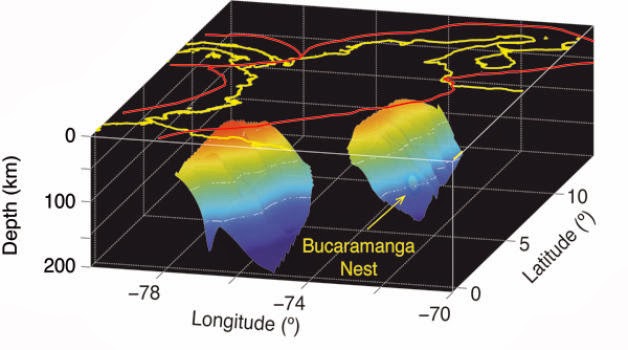
Stanford researchers have uncovered a vital clue about the mechanism behind a type of earthquake that originates deep within Earth and accounts for a quarter of all temblors worldwide, some of which are strong enough to pose a safety hazard.
Stanford scientists may have solved the mystery of what drives a type of earthquake that occurs deep within Earth and accounts for one in four quakes worldwide.
Known as intermediate-depth earthquakes, these temblors originate farther down inside Earth than shallow earthquakes, which take place in the uppermost layer of Earth’s surface, called the crust. The kinds of quakes that afflict California and most other places in the world are shallow earthquakes.
“Intermediate-depth earthquakes occur at depths of about 30 miles down to about 190 miles,” said Greg Beroza, a professor of geophysics at Stanford and a coauthor of a new study that will be published in an upcoming issue of the journal Geophysical Research Letters.
Unlike shallow earthquakes, the cause of intermediate quakes is not well-understood. Part of the problem is that the mechanism for shallow earthquakes should not physically work for quakes at greater depths.
“Shallow earthquakes occur when stress building up at faults overcomes friction, resulting in sudden slip and energy release,” Beroza said. “That mechanism shouldn’t work at the higher pressures and temperatures at which intermediate depth earthquakes occur.”
A better understanding of intermediate-depth quakes could help scientists forecast where they will occur and the risk they pose to buildings and people.
“They represent 25 percent of the catalog of earthquakes, and some of them are large enough to produce damage and deaths,” said study first author Germán Prieto, an assistant professor of geophysics at the Massachusetts Institute of Technology.
A tale of two theories
There are two main hypotheses for what may be driving intermediate depth earthquakes. According to one idea, water is squeezed out of rock pores at extreme depths and the liquid acts like a lubricant to facilitate fault sliding. This fits with the finding that intermediate quakes generally occur at sites where one tectonic plate is sliding, or subducting, beneath another.
“Typically, subduction involves oceanic plates whose rocks contain lots of water,” Beroza said.
A competing idea is that as rocks at extreme depths deform, they generate heat due to friction. The heated rocks become more malleable, or plastic, and as a result slide more easily against each other. This can create a positive feedback loop that further weakens the rock and increases the likelihood of fault slippage.
“It’s a runaway process in which the increasing heat generates more slip, and more slip generates more heat and so on,” Prieto said.
To distinguish between the two possible mechanisms, the scientists studied a site near the city of Bucaramanga in Colombia that boasts the highest concentration of intermediate quakes in the world. About 18 intermediate depth temblors rattle Bucaramanga every day. Most are magnitude 2 to 3, weak quakes that are detectable only by sensitive instruments.
But about once a month one occurs that is magnitude 5 or greater — strong enough to be felt by the city’s residents. Moreover, past studies have revealed that most of the quakes appear to be concentrated at a site located about 90 miles beneath Earth’s surface that scientists call the Bucaramanga Nest.
A natural laboratory
This type of clustering is highly unusual and makes the Bucaramanga Nest a “natural laboratory” for studying intermediate depth earthquakes. Comparison studies of intermediate quakes from different parts of the world are difficult because the makeup of Earth’s crust and mantle can vary widely by location.
In the Bucaramanga Nest, however, the intermediate quakes are so closely packed together that for the purposes of scientific studies and computer models, it’s as if they all occurred at the same spot. This vastly simplifies calculations, Beroza said.
“When comparing a magnitude 2 and a magnitude 5 intermediate depth earthquake that are far apart, you have to model everything, including differences in the makeup of the Earth’s surface,” he said. “But if they’re close together, you can assume that the seismic waves of both quakes suffered the same distortions as they traveled toward the Earth’s surface.”
By studying seismic waves picked up by digital seismometers installed on Earth’s surface above the Bucaramanga Nest, the scientists were able to measure two key parameters of the intermediate quakes happening deep underground.
One, called the stress drop, allowed the team to estimate the total amount of energy released during the fault slips that caused the earthquakes. The other was radiated energy, which is a measure of how much of the energy generated by the fault slip is actually converted to seismic waves that propagate through Earth to shake the surface.
Two things immediately stood out to the researchers. One was that the stress drop for intermediate quakes increased along with their magnitudes. That is, larger intermediate quakes released proportionally more total energy than smaller ones. Second, the amount of radiated energy released by intermediate earthquakes accounted for only a tiny portion of the total energy as calculated by the stress drop.
“For these intermediate-depth earthquakes in Colombia, the amount of energy converted to seismic waves is only a small fraction of the total energy,” Beroza said.
The implication is that intermediate earthquakes are expending most of their energy locally, likely in the form of heat.
“This is compelling evidence for a thermal runaway failure mechanism for intermediate earthquakes, in which a slipping fault generates heat. That allows for more slip and even more heat, and a positive feedback loop is created,” said study coauthor Sarah Barrett, a Stanford graduate student in Beroza’s research group.
Note : The above story is based on materials provided by Stanford University. The original article was written by Ker Than.










